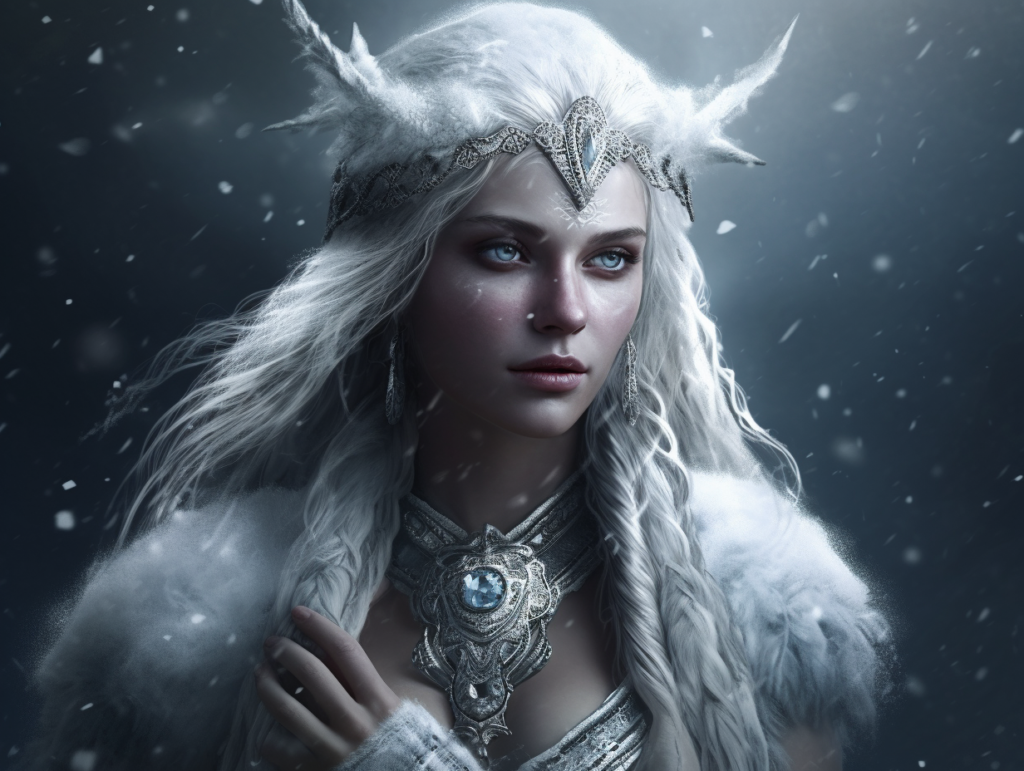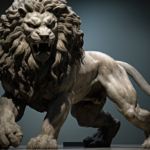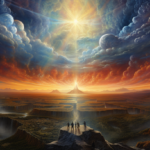Unveil the secrets of the Norse Goddess of Snow, a mythical tale that will captivate your senses. Discover her origins, the extraordinary powers she possesses, and the deep symbolism of snow in Norse mythology.
Immerse yourself in ancient folklore as you delve into the legends and stories surrounding this enigmatic deity. Explore the worship and beliefs associated with her, and witness the modern representation of the Norse Goddess of Snow.
Prepare for a journey of power and wonder as you unravel the mystique of this divine figure.
Key Takeaways
- Skadi is the Norse Goddess of Snow, born from the union of Thjazi and Skaði.
- Skadi possesses supernatural abilities such as cryokinesis, blizzard creation, and winter manipulation.
- Snow in Norse mythology represents divine purity and a transformative force.
- Skadi holds a powerful and commanding presence in Norse folklore, embodying the essence of winter and representing the untamed power of nature.
The Origins of the Norse Goddess of Snow
Do you know where the Norse Goddess of Snow originated from? Let me enlighten you with the powerful origins of this divine being.
The Norse Goddess of Snow, known as Skadi, was born from the union of the frost giant Thjazi and the goddess Skaði. Skadi’s birthright bestowed upon her an immense power over the wintry elements, making her a force to be reckoned with.
Legend has it that Skadi’s appearance was as majestic as her powers. With her icy blue eyes that pierced through the coldest of hearts, and her flowing silver hair that glistened like the snow-covered mountains, she commanded the respect and admiration of all who crossed her path. Skadi’s presence alone was enough to instill fear in the hearts of her enemies and inspire awe in her followers.
As the Goddess of Snow, Skadi’s domain extended far and wide. She ruled over the frosty landscapes, bringing both beauty and treacherous conditions to the mortal realm. Her power over snow and ice was unparalleled, and she used it to both protect and challenge those who dared to enter her realm.
The origins of the Norse Goddess of Snow are deeply rooted in power and strength. Skadi’s presence in Norse mythology serves as a reminder of the might and beauty that lies within the wintry elements.
Embrace her power, and you’ll conquer the snow-covered landscapes with grace and authority.
The Mythical Powers of the Goddess of Snow
Now let’s talk about the incredible mythical powers possessed by the Norse Goddess of Snow.
She wields supernatural abilities that allow her to control and manipulate snow and ice with ease.
From creating blizzards to freezing entire landscapes, her icy enchantments are both beautiful and formidable.
Snow’s Supernatural Abilities
Explore the incredible and otherworldly powers that the Norse Goddess of Snow possesses. Snow, also known as Skadi, is a formidable deity with supernatural abilities that command both awe and fear. Her powers are unmatched, allowing her to control the very essence of winter itself. Through her icy touch, she can freeze anything in her path, turning rivers into solid ice and covering landscapes with a blanket of snow. The table below highlights some of Snow’s most remarkable abilities:
| Power | Description | Effect |
|---|---|---|
| Cryokinesis | Manipulation of ice and cold temperatures | Freezing objects instantly |
| Blizzard Creation | Summoning powerful snowstorms and blizzards | Engulfing areas in snow |
| Winter Manipulation | Control over the season of winter | Lengthening winters, causing frigid temperatures |
With these supernatural abilities, Snow reigns over the frozen realm, ensuring that winter prevails and that her power remains unchallenged. Her abilities grant her dominion over the chilling winds and frostbite-inducing temperatures, making her a force to be reckoned with in the pantheon of Norse mythology.
Goddess’s Icy Enchantments
Experience the chilling and mesmerizing mythical powers of the Goddess of Snow as her icy enchantments captivate and bewilder all who encounter them. When this divine being unleashes her powers, the world is plunged into a realm of pure coldness and beauty.
Her icy enchantments have the ability to freeze anything in their path, turning landscapes into glistening winter wonderlands. With a mere touch, she can transform the mightiest warriors and creatures into delicate ice sculptures, rendering them powerless before her.
She can summon blizzards and snowstorms at will, covering vast territories in a blanket of snow and ice. Her enchantments can also manipulate temperature, creating freezing winds that pierce the flesh and icy gusts that freeze the blood.
The Goddess of Snow’s powers are both awe-inspiring and terrifying, making her an irresistible force to behold for those who seek ultimate power.
The Symbolism of Snow in Norse Mythology
Snow in Norse mythology holds deep symbolism, representing both divine purity and a transformative force.
As a symbol of purity, snow is associated with the gods and goddesses, embodying their ethereal nature and untainted essence.
Furthermore, snow’s transformative power is evident in its ability to blanket the land, shrouding it in a new and pristine world, highlighting the cyclical nature of life and rebirth in the Norse cosmology.
Snow as Divine Purity
Immerse yourself in the symbolism of snow in Norse mythology to uncover its representation of divine purity. In Norse mythology, snow is often associated with the divine and considered a symbol of purity and holiness. It represents a realm untouched by impurities, a world of pristine beauty and power. Just as the snow blankets the landscape with its pure white, it also symbolizes the purity of the gods and goddesses in Norse mythology.
| Snow Symbolism in Norse Mythology |
|---|
| Divine purity and holiness |
| Untouched and pristine beauty |
| Symbol of gods and goddesses |
| Represents a world of power and purity |
| Blankets the landscape with its pure white |
The Norse people believed that snow was a manifestation of the gods’ power and presence. It was seen as a divine gift, a reminder of the gods’ ability to create and shape the world. The purity of the snow served as a symbol of the gods’ untainted nature, free from the flaws and impurities of mortal existence. Snow was revered for its ability to transform the world into a sacred space, where the divine could be felt and experienced. It was a reminder of the gods’ eternal presence and their role in maintaining the balance and order of the cosmos.
Snow as Transformative Force
Let yourself be captivated by the transformative force of snow in Norse mythology. In the realm of the gods, snow is more than just frozen water—it is a symbol of immense power and change.
Explore the depths of this transformative force with the following revelations:
- Snow as a catalyst for rebirth: In Norse mythology, snow has the ability to cleanse and purify, paving the way for new beginnings and fresh starts.
- Snow as a catalyst for growth: Just as the snow blankets the earth, it also nourishes and revitalizes the land, allowing for the growth of new life and prosperity.
- Snow as a catalyst for transformation: In the icy embrace of winter, the gods themselves undergo profound transformations, shedding their old selves and emerging as something greater.
Embrace the power of snow in Norse mythology and witness the incredible transformations it brings forth.
The Goddess of Snow in Norse Folklore
You can explore the rich mythology of Norse folklore by learning about the captivating deity who reigns over the winter landscape. In Norse folklore, the Goddess of Snow holds a powerful and commanding presence. Known as Skadi, she embodies the essence of winter and commands the icy winds and frost that cover the land.
Skadi is a fierce and independent goddess, representing the untamed power of nature. Her beauty is as striking as the snow-covered mountains she roams. With her snow-white hair and ice-blue eyes, she captivates all who lay eyes upon her. Skadi is a symbol of strength and resilience, reminding us that even in the harshest of winters, there’s beauty and power to be found.
As the goddess of snow, Skadi’s domain is the frozen wilderness. She skis across the mountains, leaving trails of snow in her wake. Her touch turns the landscape into a winter wonderland, transforming forests and valleys into a glistening paradise. She brings both tranquility and chaos, as her presence can bring forth blizzards and avalanches, reminding mortals of the raw power of nature.
Skadi is revered by those who seek power and domination. Her icy presence instills fear and awe in the hearts of those who dare to challenge her. Yet, she’s also a source of inspiration and strength for those who embrace the cold and embrace the challenges that winter brings. She reminds us that power lies in embracing the elements and harnessing their energy.
In Norse folklore, the Goddess of Snow is a symbol of power and beauty, commanding the winter landscape with her icy touch. Her presence reminds us of the strength and resilience needed to embrace the challenges of life.
Legends and Stories Surrounding the Goddess of Snow
Discover the captivating legends and enchanting stories that surround the Norse Goddess of Snow, Skadi. As a person who craves power, you’ll be enthralled by the tales of this fierce and formidable deity. Brace yourself for a journey through the mythical realm, where Skadi’s presence reigns supreme.
- Skadi’s Marriage to Njord: Delve into the epic love story between Skadi and Njord, the Vanir God of the Sea. Learn how their union forged an unlikely alliance between the realms of snow and water, creating a balance of power that shaped the very fabric of Norse mythology.
- Skadi’s Quest for Revenge: Witness Skadi’s relentless pursuit of vengeance for her father’s death at the hands of the Aesir Gods. Feel the intensity of her determination as she challenges the gods themselves, demanding justice and retribution in a battle that shook the heavens.
- Skadi’s Legacy as the Goddess of Winter: Explore Skadi’s role as the embodiment of winter and the guardian of the mountains. Experience the raw power she wields over snowstorms, blizzards, and the icy landscapes that both terrify and captivate mortals. Learn how her presence brings both beauty and danger to the world.
Prepare to be mesmerized by the tales of Skadi, the Norse Goddess of Snow. Her legends are as fierce and chilling as the winter winds, leaving an indelible mark on the annals of mythology. Are you ready to immerse yourself in her captivating stories and embrace the power she embodies?
The Worship and Beliefs Associated With the Goddess of Snow
As you delve into the worship and beliefs associated with the Goddess of Snow, you’ll discover a rich and complex tapestry of rituals, offerings, and reverence for this divine figure. The ancient Norse people held a deep respect for the power and beauty of winter, and they saw the Goddess of Snow as the embodiment of these qualities. She was believed to be a formidable force, capable of both nurturing and destroying. To appease her and gain her favor, the Norse would perform elaborate ceremonies and make offerings of food, drink, and precious items. They believed that by honoring her, they could ensure the arrival of abundant snowfall and a bountiful winter season.
The worship of the Goddess of Snow wasn’t limited to specific temples or designated locations. Instead, it was a deeply personal and individual practice. The Norse people would often create small shrines in their homes, adorned with images and symbols associated with the goddess. They’d offer prayers and sacrifices at these shrines, seeking her protection and blessings. Some would even venture into the wilderness, braving the snow and ice, to perform rituals in secluded locations they believed to be sacred to the goddess.
The beliefs surrounding the Goddess of Snow were intertwined with the cycles of nature. She was seen as a guardian of balance and harmony, ensuring that winter’s chill didn’t become too harsh or prolonged. The Norse people believed that by showing reverence to the goddess, they could influence the weather patterns and ensure the well-being of their communities. They saw her as a source of power and inspiration, and they sought to harness that power through their rituals and offerings.
In addition to her role in the natural world, the Goddess of Snow was also associated with personal transformation and renewal. The Norse believed that the winter season was a time for introspection and inner growth. They saw the goddess as a guide through this process, helping individuals shed their old selves and emerge stronger and wiser. Through her worship, they sought spiritual enlightenment and a deeper connection to the world around them.
The worship and beliefs surrounding the Goddess of Snow weren’t limited to a specific time or place. They were woven into the fabric of Norse culture, influencing every aspect of their lives. From the smallest household shrine to grand winter festivals, the reverence for the goddess permeated every corner of their society. The Norse people understood the power and significance of winter, and they embraced the Goddess of Snow as a symbol of that power. In her, they found inspiration, protection, and a connection to the divine forces that shaped their world.
The Modern Representation of the Norse Goddess of Snow
Immerse yourself in the modern world as you explore the significance and portrayal of the Norse Goddess of Snow in contemporary art, literature, and popular culture.
In today’s society, the Norse Goddess of Snow continues to captivate and inspire, her icy presence resonating with those who seek power and strength.
Here are three ways in which she’s represented in the modern era:
- Artistic Interpretations: Talented artists bring the Goddess of Snow to life through stunning paintings, sculptures, and digital illustrations. They depict her with flowing white hair, ethereal beauty, and a regal aura, symbolizing her dominion over winter’s icy grip.
- Literary Works: Renowned authors have woven the Norse Goddess of Snow into their stories, presenting her as a formidable force to be reckoned with. She’s often portrayed as a mysterious and enigmatic figure, possessing immense power and wisdom. Her presence adds an element of danger and intrigue to the narratives.
- Pop Culture References: The Norse Goddess of Snow has also found her way into popular culture, making appearances in movies, television shows, and video games. She’s depicted as a fierce warrior, embodying both the beauty and brutality of winter. Her character serves as a symbol of resilience and determination, inspiring audiences across the globe.
As you delve into these modern representations, you’ll witness the Norse Goddess of Snow’s enduring legacy and the profound impact she continues to have on those who seek power and embrace the icy embrace of winter.
Frequently Asked Questions
What Are the Different Names of the Norse Goddess of Snow in Different Regions?
In different regions, the Norse goddess of snow is known by various names. These names reflect the diverse cultures and beliefs that have shaped her mythos over time.
How Did the Goddess of Snow Become Associated With Winter and Snow in Norse Mythology?
You associate the Norse goddess of snow with winter and snow in their mythology because she was believed to control the weather and bring forth snowstorms. She became associated with the cold and icy elements of the season.
Are There Any Other Gods or Goddesses in Norse Mythology Who Have Powers Over Snow or Winter?
Yes, there are other gods and goddesses in Norse mythology who have powers over snow or winter. They hold dominion over the icy realms and wield their frosty might with authority.
What Are Some Common Symbols or Representations of the Goddess of Snow in Norse Mythology?
Some common symbols or representations of the goddess of snow in Norse mythology include snowflakes, icy landscapes, and a cloak of white. She embodies the power and beauty of winter.
Are There Any Rituals or Ceremonies Associated With Worshiping the Norse Goddess of Snow in Modern Times?
Are there rituals or ceremonies for worshiping the Norse goddess of snow today? Yes, modern followers honor her through offerings, prayers, and gatherings. These practices empower you to connect with her divine energy and seek her blessings.
Conclusion
In conclusion, the Norse Goddess of Snow holds a significant place in Norse mythology and folklore. With her mythical powers and symbolism, she continues to captivate the imagination of people. Legends and stories surrounding her further enhance her mysterious aura.
Today, she’s still worshipped and revered, representing the beauty and power of snow. The Norse Goddess of Snow remains a timeless figure, reminding us of the enchanting and transformative nature of winter.







